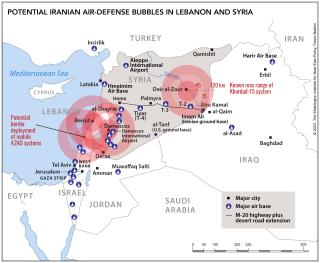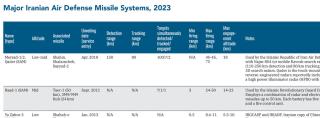Iran potentially expanding its air defence axis in Lebanon, Syria
The Washington Institute has published an article arguing that Tehran is seemingly redoubling its efforts to equip Hezbollah and other regional allies with advanced air defence systems, potentially affecting Israeli and U.S. calculations in the Gaza war and beyond. Caliber.Az reprints the article.
Reports out of Syria’s Deir al-Zour province suggest that militias may be actively training to use Iran’s 15th of Khordad (Khordad-15) advanced medium-to-high-altitude air defence missile system, which is similar to the U.S. military’s Patriot system. The presence of Khordad-15 units inside Syria has not been confirmed, and their ultimate destination is unknown if they have in fact been transferred there. Yet Damascus and Tehran reportedly reached a deal in July 2020 to supply the Assad regime with a number of Iranian air defence systems, including the Khordad-15, which can reportedly engage up to six fighter-jet-size targets simultaneously from a range of 120 kilometres.
That deal was also presumably intended to benefit Hezbollah, Tehran’s chief regional proxy and long an active player in covertly transferring advanced weapons through Syria into Lebanon. The prospect of a sophisticated system like the Khordad-15 being introduced in south Lebanon or southwest Syria is particularly alarming in the current context of Israel’s war with Hamas, its widening border clashes with Hezbollah, and the U.S. military’s attempts to counter increased strikes by Syrian and Iraqi militias. On paper, the Khordad-15 would significantly improve proxy efforts to counter Israeli air operations along border areas or deeper inside Lebanon and Syria—especially if paired with a point-defence system like the Pantsir, which Russia’s Wagner Group reportedly plans to deliver to Hezbollah.

Boosting Air Defenses for Hezbollah and Other Proxies
Hezbollah’s ability to engage aerial targets is currently limited to short-range antiaircraft guns, man-portable air defence systems (MANPADS) such as the Russian-made Strella-3 and Igla-1 and the Iranian Misagh (a copy of the Chinese QW-1), and so-called “Item 358” air defence cruise missiles (see below). The group has reportedly fired some of these weapons at Israeli drones in recent days, and even its limited capabilities seemingly influenced the scope of Israel’s air operations well before the current regional crisis. In general, however, Hezbollah's capabilities are no match for Israel’s advanced airpower and ability to conduct standoff strikes using long-range precision munitions.
This capability gap, coupled with continuing Israeli airstrikes on Iranian military targets in Syria, prompted Tehran to accelerate its push for a regional “air defence axis” as early as 2019. Through planned or attempted weapons transfers to Iraq and Syria, the regime has sought to complicate enemy air operations in a wide area stretching from its western border all the way into Lebanon.
Evidently, it has also been transferring “Item 358” air defense cruise missiles since at least 2018—not just to Hezbollah, but also to Iraqi militias and even the Yemeni Houthis. This unique jet-powered weapon was likely used during a November 8 incident in which the Houthis claimed to shoot down an American MQ-9 reconnaissance drone over Yemeni waters.
So far, Israel seems to have thwarted most attempts to transfer Iranian and Russian medium-range air defence systems from Syria to Lebanon, including the 9K33 Osa (aka SA-8) and Buk-M2 (aka SA-17). This April, Israel struck an operational Iranian Matla-ul-Fajr early warning radar (500 km range) near Homs.
But the Khordad-15 represents a different class of air defence and could lessen this vulnerability. First unveiled in 2019, it reportedly entered service in Iran the following year. The system is road-mobile, and its components can be transported in an Il-76 cargo plane. Its engagement radar and control station are integrated on one truck, making the system quickly redeployable.
Of course, even a highly mobile system would be vulnerable to determined enemy suppression efforts, especially if deployed near the Israeli border in a theatre antiaccess/area denial (A2AD) role. Protecting the Khordad-15 with the aforementioned Pantsir system (20 km engagement range) could alleviate this vulnerability somewhat.
Alternatively, Khordads could be deployed deeper inside Lebanese or Syrian territory to better defend Damascus airport, Beirut (including Hezbollah’s stronghold in the Dahiya neighbourhood), and the strategic highway connecting the two capitals. Theoretically, both countries could even extend their air defence bubbles further than the Khordad-15’s current 120 km limit if Iran configures the system to fire longer-range missiles (e.g., up to 200 km) or sends more advanced systems from its domestic arsenal.

Iranian air defence systems are generally designed with ease of operation in mind, and the Khordad-15 is unlikely to be an exception—a combination of Iranian, Hezbollah, Syrian, and probably Iraqi crews and technical advisors should be able to operate it effectively in the near term. Yet the system may not have reached its full operational capability even after being in service for three years, and Iran’s production rate for such systems is believed to be slow. Therefore, urgently supplying militias or Syrian military forces with the Khordad-15 would likely require Iran to draw from its domestic inventory of these systems and use personnel from the Islamic Republic of Iran Air Defense Force (IRIADF) to help man and maintain them.
Air Defense as “the First Priority”
In 2008, Iranian Supreme Leader Ali Khamenei issued a decree putting air defence on par with the regime’s all-important ballistic missile program and establishing a unified air defence force. By 2019, the IRIADF had become an independent branch of the national armed forces, overseen by a new air defence headquarters that included elements of the Islamic Revolutionary Guard Corps (IRGC) air defence command.
The regime has been particularly active in developing an integrated domestic air defence network—an objective that required a specialized indigenous industrial base capable of producing numerous types of radars, communications nodes, and mixed-range missile batteries without major foreign help (though obviously incorporating many designs, electronics, and subsystems from Russia, China, and Western countries). Iran’s native capabilities have been further boosted by its acquisition of the Russian Tor-M1 surface-to-air missile (SAM) system in 2006 and the S-300 in 2016.
Tehran has also been keen to export its homemade arms, especially now that the relevant restrictions in UN Security Council Resolution 2231 have formally expired. Prior to the new Khordad-15 reports from Syria, however, there was little evidence that the regime had actually succeeded in transferring any such systems, aside from a single Sayyad-2C missile round caught by Saudi Arabia before it reached the Houthis in 2018 (probably intended for reverse engineering).
Conclusion
Iran and its “axis of resistance” proxies have long relied on asymmetric means to disrupt their two perceived archenemies, Israel and the United States. Toward that end, they have continuously expanded their rocket and missile arsenals as a means of compensating for their inability to pose any challenge in the air—an effort that further evolved with the advent of more effective Israeli counter-missile systems (e.g., Iron Dome) and Iran’s development of modern air defence systems. Going forward, Tehran can be expected to continue exploring all available options to both improve the air defence capabilities of its proxies and constrain the air operations of its enemies via innovative A2AD strategies.
Currently, no UN sanctions preclude Iran from selling and transporting air defence systems to its allies unless the recipient is itself under sanctions. And with Russia and China sitting on the Security Council, there is zero chance of imposing any new UN-sponsored measure against Iranian weapons exports. Accordingly, Washington will need to keep a close eye on Tehran’s air defence transactions with the help of U.S. partners in the Middle East, if necessary using its regional leverage and other tools to prevent or disrupt transfers of key systems by land or sea.








